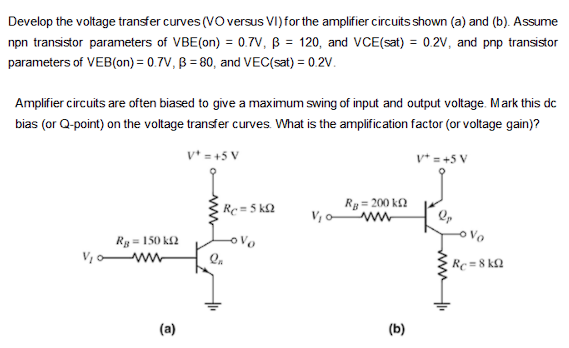Develop the voltage transfer curves (vO versus VI) for the amplifier circuits shown (a) and (b). Assume npn transistor parameters of VBE(on) = 0.7V, ß = 120, and VCE(sat) = 0.2V, and pnp transistor parameters of VEB(on) = 0.7V, ß = 80, and VEC(sat) = 0.2V. Amplifier circuits are often biased to give a maximum swing of input and output voltage. Mark this do bias (or Q-point) on the voltage transfer curves What is the amplification factor (or voltage gain)? v* = +5 V v*=+5 V Re=5 k2 Ry = 200 k2 V, o ww Vo Ry= 150 k2 V, o ww Vo Re=8 k2 ww.
Develop the voltage transfer curves (vO versus VI) for the amplifier circuits shown (a) and (b). Assume npn transistor parameters of VBE(on) = 0.7V, ß = 120, and VCE(sat) = 0.2V, and pnp transistor parameters of VEB(on) = 0.7V, ß = 80, and VEC(sat) = 0.2V. Amplifier circuits are often biased to give a maximum swing of input and output voltage. Mark this do bias (or Q-point) on the voltage transfer curves What is the amplification factor (or voltage gain)? v* = +5 V v*=+5 V Re=5 k2 Ry = 200 k2 V, o ww Vo Ry= 150 k2 V, o ww Vo Re=8 k2 ww.
Introductory Circuit Analysis (13th Edition)
13th Edition
ISBN:9780133923605
Author:Robert L. Boylestad
Publisher:Robert L. Boylestad
Chapter1: Introduction
Section: Chapter Questions
Problem 1P: Visit your local library (at school or home) and describe the extent to which it provides literature...
Related questions
Question

Transcribed Image Text:Develop the voltage transfer curves (VO versus VI) for the amplifier circuits shown (a) and (b). Assume
npn transistor parameters of VBE(on) = 0.7V, ß = 120, and VCE(sat) = 0.2V, and pnp transistor
parameters of VEB(on) = 0.7V, B = 80, and VEC(sat) = 0.2V.
Amplifier circuits are often biased to give a maximum swing of input and output voltage. Mark this dc
bias (or Q-point) on the voltage transfer curves. What is the amplification factor (or voltage gain)?
v* = +5 V
v* = +5 V
Re = 5 k2
Ry = 200 k2
V, o ww
Rg = 150 k2
V,o ww
Rc = 8 k2
(a)
(b)
Expert Solution
This question has been solved!
Explore an expertly crafted, step-by-step solution for a thorough understanding of key concepts.
Step by step
Solved in 6 steps with 6 images

Knowledge Booster
Learn more about
Need a deep-dive on the concept behind this application? Look no further. Learn more about this topic, electrical-engineering and related others by exploring similar questions and additional content below.Recommended textbooks for you

Introductory Circuit Analysis (13th Edition)
Electrical Engineering
ISBN:
9780133923605
Author:
Robert L. Boylestad
Publisher:
PEARSON

Delmar's Standard Textbook Of Electricity
Electrical Engineering
ISBN:
9781337900348
Author:
Stephen L. Herman
Publisher:
Cengage Learning

Programmable Logic Controllers
Electrical Engineering
ISBN:
9780073373843
Author:
Frank D. Petruzella
Publisher:
McGraw-Hill Education

Introductory Circuit Analysis (13th Edition)
Electrical Engineering
ISBN:
9780133923605
Author:
Robert L. Boylestad
Publisher:
PEARSON

Delmar's Standard Textbook Of Electricity
Electrical Engineering
ISBN:
9781337900348
Author:
Stephen L. Herman
Publisher:
Cengage Learning

Programmable Logic Controllers
Electrical Engineering
ISBN:
9780073373843
Author:
Frank D. Petruzella
Publisher:
McGraw-Hill Education

Fundamentals of Electric Circuits
Electrical Engineering
ISBN:
9780078028229
Author:
Charles K Alexander, Matthew Sadiku
Publisher:
McGraw-Hill Education

Electric Circuits. (11th Edition)
Electrical Engineering
ISBN:
9780134746968
Author:
James W. Nilsson, Susan Riedel
Publisher:
PEARSON

Engineering Electromagnetics
Electrical Engineering
ISBN:
9780078028151
Author:
Hayt, William H. (william Hart), Jr, BUCK, John A.
Publisher:
Mcgraw-hill Education,